#Yalta palaces
Video
youtube
Ласточкино гнездо #travel #ялта #ласточкиногнездо #крым
#крым#ялта#гаспра#ласточкино гнездо#черное море#путешествие#yalta#crimea#castle#russia#black sea#travel#gaspra#palace
11 notes
·
View notes
Text
Paralells-Crimea



#paralells#romanov family#crimea#house of romanov#otmaa#tsar nicholas ii#livadia palace#livadia#yalta#alexandra feodorovna#summer vacation#summer#summertime#romanovs
27 notes
·
View notes
Text





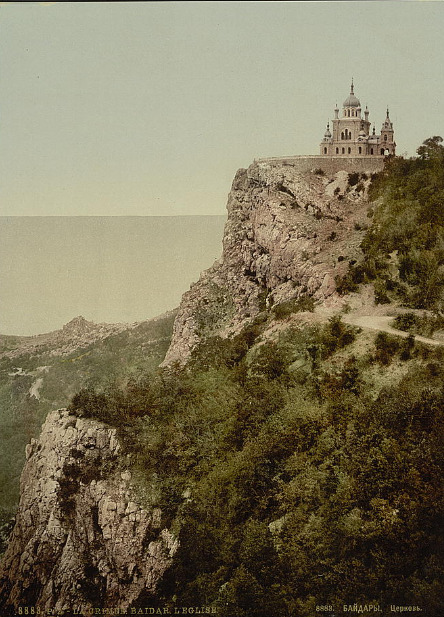
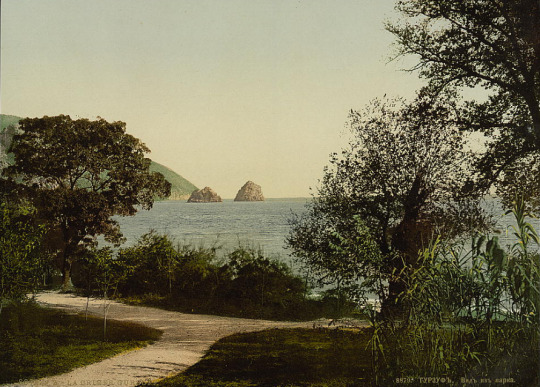
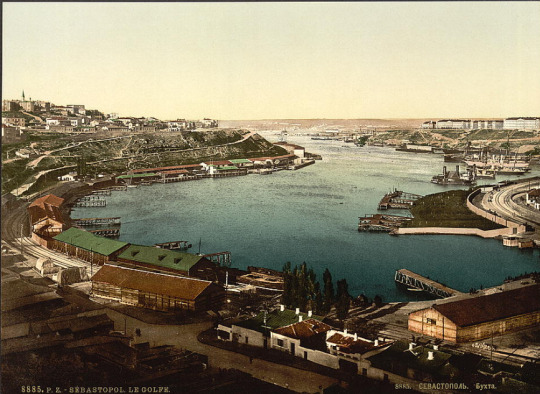


From the boulevard Yalta, the Crimea , Ukraine
2. The gulf, Yalta, the Crimea, Ukraine
3. Gurzuf from the Yalta Road, the Crimea, Ukraine
4. Gurzuf, the Crimea, Ukraine
5. The Crimea, Alupka. The Imperial palace, Ukraine
6. The church, Baidar, the Crimea, Ukraine
7. Gurzuf, from the Park, the Crimea, Ukraine
8. The gulf, Sebastopol, Ukraine
9. The Khan's palace, Bakhchysaraĭ, Ukraine
10. The harem, Bakhchysaraĭ, Ukraine
Photos were published between 1890 and 1900 and are part of The Photochrom Print Collection, which has almost 6,000 views of Europe and the Middle East and 500 views of North America. Published primarily from the 1890s to 1910s, these prints were created by the Photoglob Company in Zürich, Switzerland, and the Detroit Publishing Company in Michigan. The richly colored images look like photographs but are actually ink-based photolithographs, usually 6.5 x 9 inches.
Source https://www.loc.gov
#ukraine#eastern europe#photography#vintage photography#xix century#19th century#crimea#color photography#architecture#cities
231 notes
·
View notes
Text
"In St. Petersburg we work, but at Livadia, we live."
Grand Duchess Olga Alexandrovna
In 1909, Nikolay Krasnov, who was responsible for the Yousupoff Palace in Koreiz, was engaged to design a new imperial palace in Livadia (before that, there had been an imperial residence in Livadia consisting of a large and a small palace used by Alexander II and later by Alexander III, who died at the smaller residence.) When Nicholas II decided to build the new palace, he also demolished the older residence but left the small palace where his father died.
The Tsar's diary indicates that the Imperial Family discussed the design; it was decided that all four façades of the palace should look different. After 17 months of construction, the new palace was inaugurated on 11 September 1911. In November, Grand Duchess Olga Nikolaevna celebrated her 16th birthday at Livadia.
The family was always the happiest at Livadia.
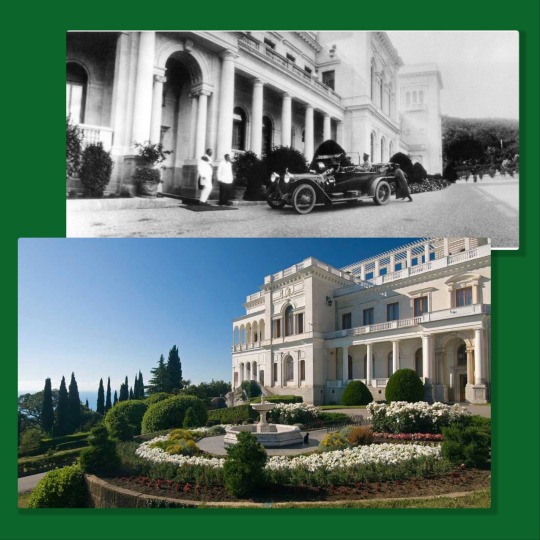
One of the Tsar's "motors" at Livadia. If you look carefully, you can see the "side of the palace" where the car is parked and the main entrance in both the contemporary colored and black and white photos.
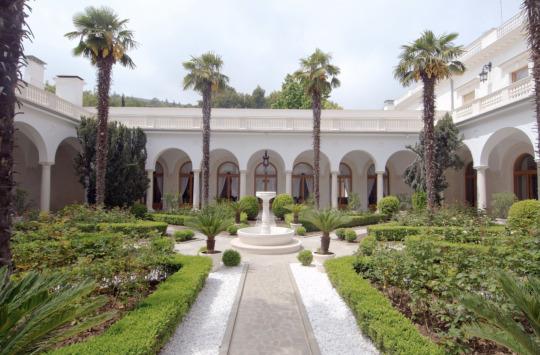
Above is the beautiful Italian Courtyard of the palace as it stands today. If you look at pictures taken when the Romanovs used the palace, the centerpiece of the courtyard was different. Today, there is a fountain at the center. Examining the older pictures (below), you can see that there seemed to be what I can only describe as a "well" at the center of the courtyard. There was a column on each side of the well. In one of the photos below, you can see Grand Duke Dmitry Pavlovich; he had his own rooms at the Livadia Palace.
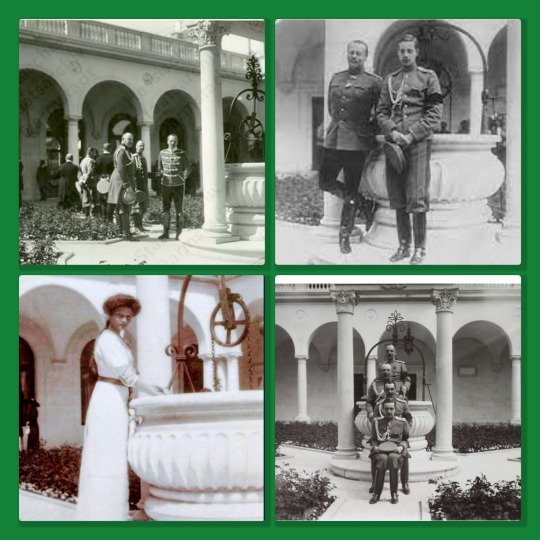
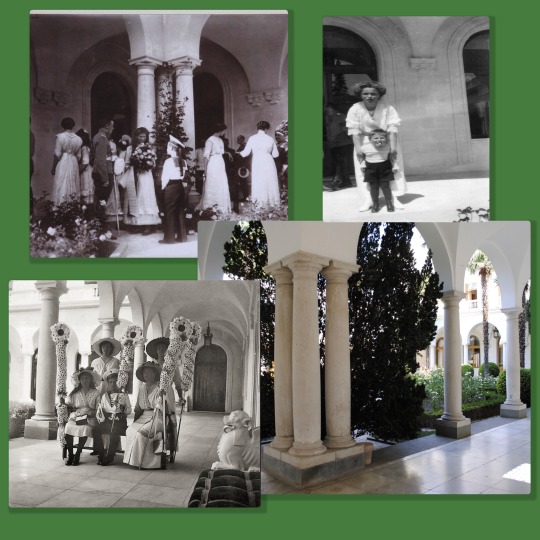
Nicholas II and his family were so at ease at Livadia that they also conducted some minor official functions in addition to family activities. When the family went to Livadia, they usually went as far as Yalta by sea; it is easy to infer that the official activities they conducted were related to the crew of the Standart. In addition, at the time, it was believed that mountain air and rest could cure tuberculosis, and there were several spas and sanatoria in the mountains in the area. The Empress and the girls visited the sick there (they also participated in other charitable activities.)



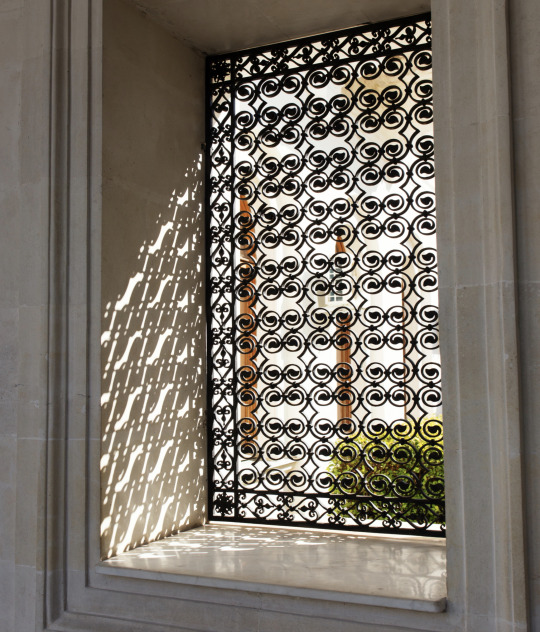
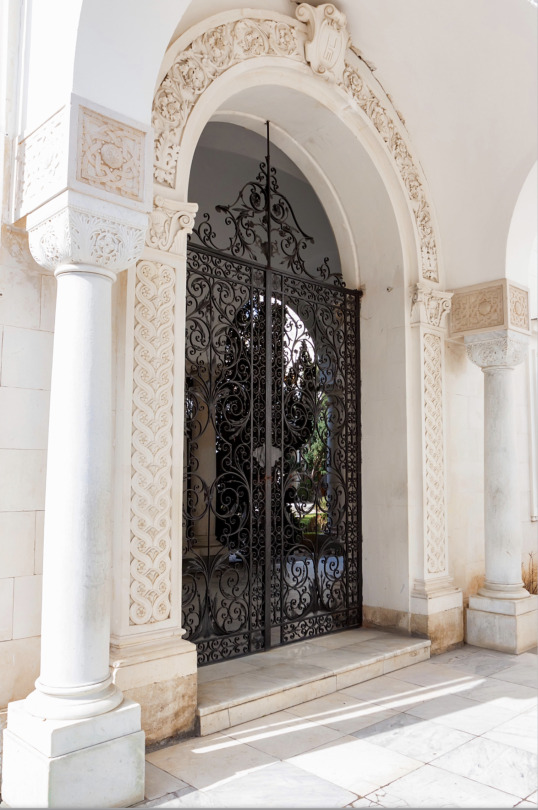
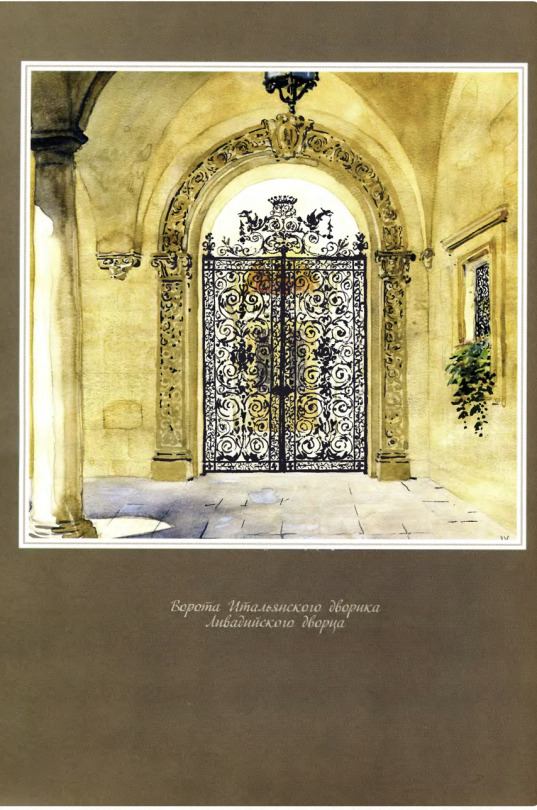
The Yousupov family gifted the beautiful door above to Nicholas and Alexandra. The painting next to it is from a beautiful book by Kravnov ("Fiftieth Anniversary of Yalta"), who worked on the palace's design (and on that of the Crimean summer residences of several Grand Dukes.) The window is also featured in the painting.
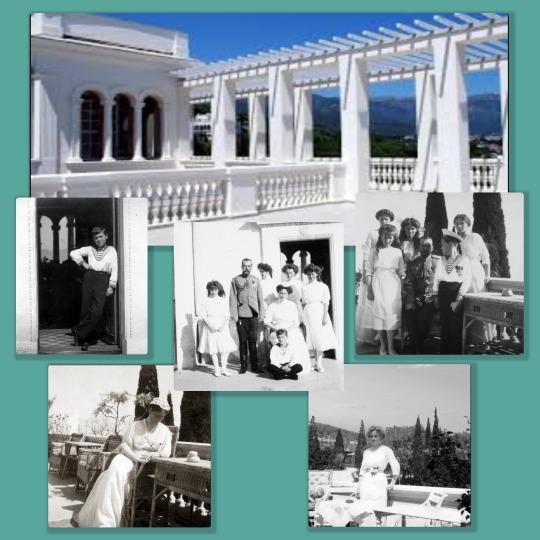
The "solarium" seems to have been a very popular area. Nicholas and his children preferred the outdoors, and Livadia seemed to provide the Empress with the perfect environment to get sun and fresh air in comfort regardless of her many ailments.

This is the "Moorish" courtyard of the palace. It is small, but notice the exquisite tilework on the walls. And, of course, the little balcony between the windows seemed perfect to Alexis for him to "address" his family.
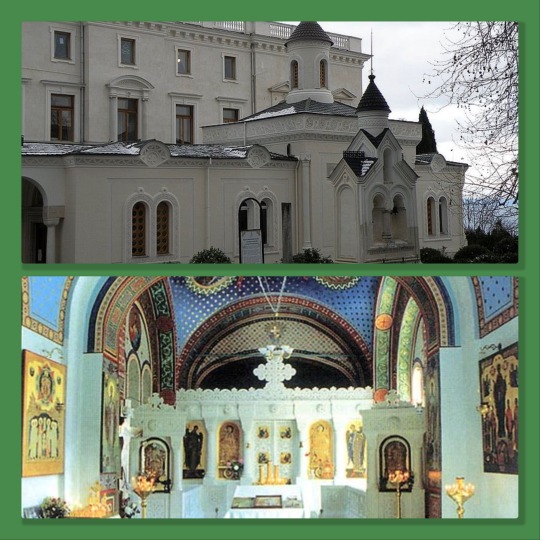
The palace had a chapel so that the Romanov family could worship in privacy.
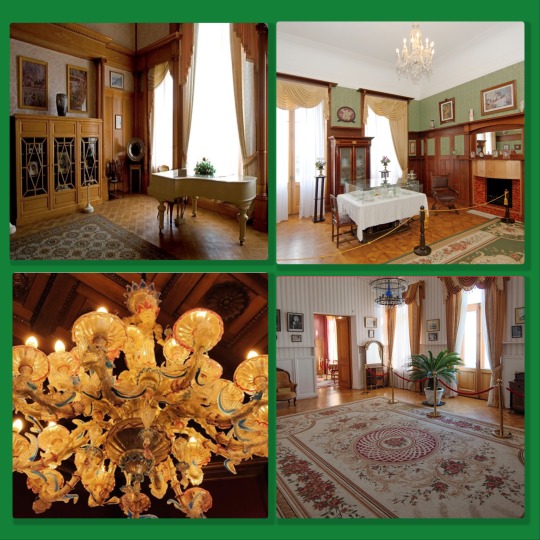

A few of the interiors of the palace. The chandelier is Murano Glass (amazing that it survived all these years.) Olga's coming-of-age celebration took place in Livadia in the formal dining room in the photograph above, dancing spilling into the flower-perfumed courtyard. That is a luxury of the type you cannot buy! The girls' rooms are currently being restored. There are pictures of the rooms as they were, but I was not sure they were from Livadia, so I did not include them.
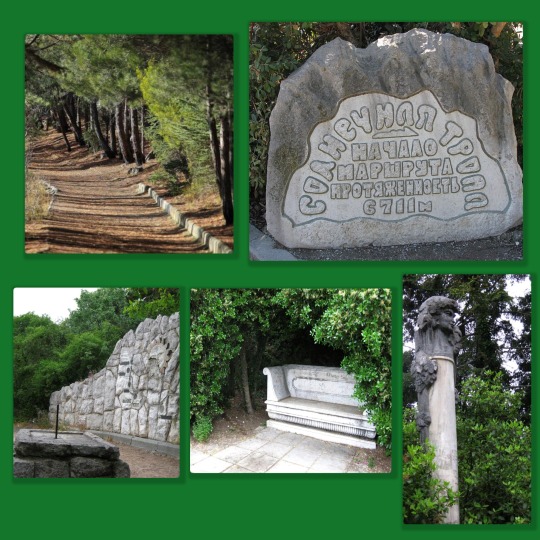

Finally, some photos of the "Tsar's Path" (or Sunny Path), which exists to this day (it goes from Livadia Park to the city of Gaspra.) The family loved to walk this path (regardless of its name, it is not sunny but pleasantly breezy). This path is on one level so that anybody can walk it, regardless of their cardiovascular status. I have read two stories about how it "emerged," and as usual, the truth is probably in the middle. First story: The new Livadia Palace did not exist yet, but the Romanovs used the old palace and always loved coming to Livadia. Alexander III kept gaining weight, and his doctor recommended that he walk but not overdo it...so Alexander had the path leveled. The path's beginning and end differed from what they would be later. Second Story: Sandro had the path from Ay Todor toward Livadia built because Nicholas and Sandro's families always visited each other (they started calling it the Prince's Path.) Nicholas loved the idea and extended the path.
Today, the main path remains, and other routes to other small towns can be hiked from it. Many of the same benches and sculptures are where they were at the time of the Romanovs.

Just one last photo. Here, you can see how close the palace is to the mountains and the sea. A beautiful big house full of fresh air and light with flowers perfuming the air. No wonder Olga liked it so much! (gcl)
#russian history#romanov dynasty#nicholas ii#otma#Empress Alexandra Feodorovna#Emperor Alexander III#Grand Duke Alexander Mikhailovich#Ay Todor#Nikolay Krasnov#grand duchess olga nicholayevna#Grand Duchess Tatiana Nicholayevna#Grand Duchess Maria Nicholayevna#Grand Duchess Anastasia Nicholayevna#Tsarevich Alexei
55 notes
·
View notes
Text

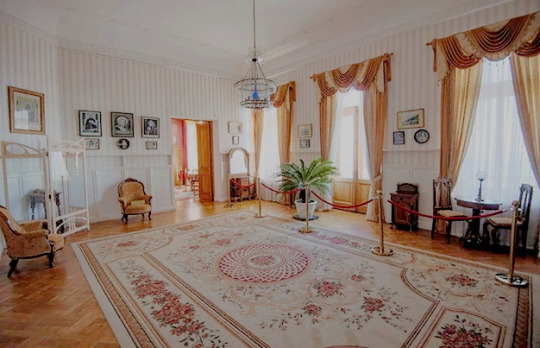

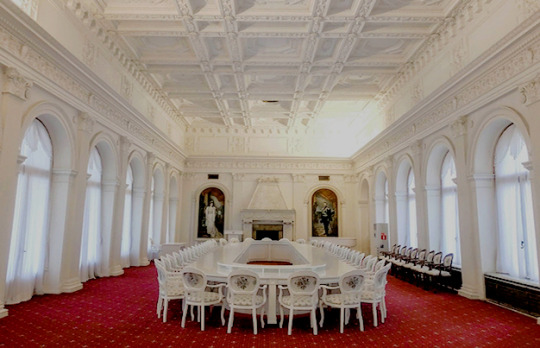

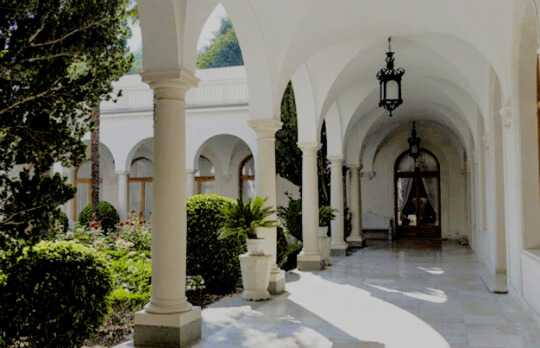
"The Livadia Palace was two-storeyed and Italian Renaissance in style, with large windows that let in the light, and faced in local white Inkerman limestone — prompting its popular name as the 'White Palace'. It had been completed inside sixteen months, including a second house for the imperial entourage, and had all the modern conveniences of central heating, lifts and telephones. Having taken possession on 20 September Nicholas wrote to his mother: 'We cannot find the words to express our joy and the pleasure of having such a house, built exactly as we wished … The views in all directions are so beautiful, especially of Yalta and the sea. There is so much light in the rooms and you remember how dark it was in the old house.' Inside all was simplicity, much in the style moderne that Alexandra favoured. The private apartments on the second floor had the preferred white furniture and chintz fabrics, and as usual there were flowers everywhere. The windows and balconies at the back of the palace gave out over the sea: Olga and Tatiana delighted in taking their morning French lessons with Pierre Gilliard out on the balcony. On the northern side of the palace facing inland, the palace looked out onto the rugged Crimean mountains in the distance. A cool and shady inner courtyard featured Italianate marble colonnades and a fountain surrounded by a pretty knot garden. It was a favourite place for the entourage to escape the heat of the day and sit and chat after luncheon."
Four Sisters: The Lost Lives of the Romanov Grand Duchesses | Helen Rappaport
80 notes
·
View notes
Text
On National Flag Day, President Volodymyr Zelenskyy took part in the solemn ceremony of raising the blue-yellow flag.
youtube

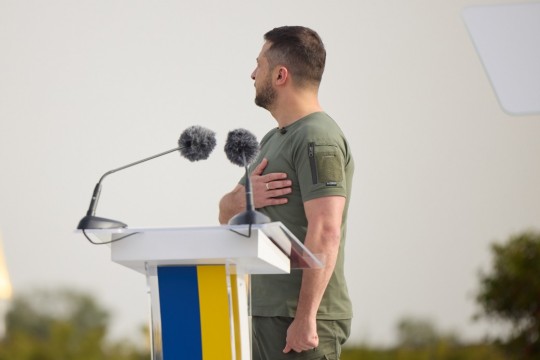




In the presence of the Head of State, the country's largest flag, located on the territory of the National Museum of the History of Ukraine in World War II, was raised in Kyiv. The solemn raising was accompanied by a military orchestra. The National Anthem was played. The honor guard company marched.
During the speech, the President noted that every year, shortly before Independence Day, the Ukrainian people pay tribute to one of their most important symbols and one of the greatest shrines - the National Flag of Ukraine.
"The combination of two colors that we incredibly love, cherish and will never exchange for any other. We will never recognize foreign colors on our land and in our sky. And we are always ready to defend our blue-yellow flag," Volodymyr Zelenskyy said.
The Head of State announced a moment of silence to commemorate the heroes who gave their lives for these colors.
The President noted that Ukraine's flag has gone through a lot and was present at many places. In particular, it was brought to the parliament on the day of the declaration of independence of Ukraine, it was in space together with Leonid Kadeniuk, at the North Pole with our polar explorers, it conquered Everest. The blue-yellow flag was also a star on the stages in Istanbul, Stockholm and Turin, when the Ukrainians who won the Eurovision wrapped themselves in it, it triumphantly rose above the flags of other countries at the Olympic Games in Atlanta, Sydney, Beijing, London and many others cities of the world.
"It also attended the 1976 Olympics in Montreal, when during the semi-final match between the USSR and GDR national football teams, Danylo Myhal, a representative of the Ukrainian diaspora in Canada, ran onto the field. Dressed in vyshyvanka and carrying a blue-yellow flag, he danced the hopak. He always dreamed of transferring this flag to Ukraine. Today it finally happened. And this legendary flag will be raised today at the opening of the Ukrainian football championship," said Volodymyr Zelenskyy.
The President also emphasized that the blue and yellow colors were on the armor and near the hearts of Ukrainian warriors when they liberated Kramatorsk, Sloviansk, Mariupol and dozens of other cities in 2014, as well as the Kyiv region, Chernihiv region, Sumy region and our other occupied lands in 2022.
"It witnessed the birth of a world masterpiece and heard firsthand where the "Russian warship" should go. Now everyone is in their place: our flag has returned to Zmiinyi Island, and the "Moskva" cruiser has followed the given course," said the Head of State.
The President expressed belief that the blue-yellow flag will fly again where it should be by right.
"In all temporarily occupied cities and villages of Ukraine. Occupied - temporarily. Fly - forever. In Melitopol, above Peremohy Square. Where there can be no flag of those who lose the war. There will be blue and yellow. In Kherson, above Svobody Square. There can be no flag of those who do not know what freedom is. There will be blue and yellow," Volodymyr Zelenskyy said.
The President emphasized that the Ukrainian flag will again be on Azovsky Avenue in Berdyansk, on Zelena Alley in Skadovsk, over the NPP in Enerhodar and over the Kakhovska HPP, on the Adzhyholsky lighthouse and on Savur-Mohyla, on the shores of Siverskyi Donets, Kalmius, near the Oleshky sands.
"There cannot be a flag of those who hear these names for the first time. There will be blue and yellow. And in Crimea. In Yalta, in Kerch, Dzhankoy, Simferopol, on Ai-Petri. Ukrainian and Crimean Tatar flags. And no matter how someone tries to twist history, exactly these colors are historically associated with Crimea," the Head of State emphasized.
The blue-yellow flag will also be in Lutuhyne, over the Taras Shevchenko House of Culture, in Lysychansk, over the Volodymyr Sosiura Palace of Culture, because there cannot be another flag next to these names, Volodymyr Zelenskyy is convinced.
"Our flag will fly again in Milove, near the Bell of Memory and the memorial to the victors of Nazism. And it will be in Severodonetsk, next to the monument to the Cossacks. There should not be a flag of those who have nothing to do with either the first or the second. There will be blue and yellow. Our Ukrainian flag. Our amulet. Amulet of Ukraine. From land to the skies! Happy National Flag Day," the President summed up.
According to the Constitution, the national symbols of Ukraine are the National Flag, the National Coat of Arms, and the National Anthem of Ukraine. The National Flag is a flag made of two equal-sized horizontal stripes of blue and yellow colors.
#president zelensky#volodymyr zelensky#volodymyr zelenskyy#wolodymyr selenskyj#president zelenskyy#selenskyj#volodomir zelensky#president volodymyr zelenskyy#vladimir zelensky#volodimir zelenski#zelensky#zelenski#selenski#Youtube#ukraine#war#russia
11 notes
·
View notes
Text
Events 2.4 (before 1950)
211 – Following the death of the Roman Emperor Septimius Severus at Eboracum (modern York, England) while preparing to lead a campaign against the Caledonians, the empire is left in the control of his two quarrelling sons, Caracalla and Geta, whom he had instructed to make peace.
960 – Zhao Kuangyin declares himself Emperor Taizu of Song, ending the Later Zhou and beginning the Song dynasty.
1169 – A strong earthquake strikes the Ionian coast of Sicily, causing tens of thousands of injuries and deaths, especially in Catania.
1454 – Thirteen Years' War: The Secret Council of the Prussian Confederation sends a formal act of disobedience to the Grand Master of the Teutonic Knights, sparking the Thirteen Years' War.
1555 – John Rogers is burned at the stake, becoming the first English Protestant martyr under Mary I of England.
1703 – In Edo (now Tokyo), all but one of the Forty-seven Ronin commit seppuku (ritual suicide) as recompense for avenging their master's death.
1758 – The city of Macapá in Brazil is founded by Sebastião Veiga Cabral.
1789 – George Washington is unanimously elected as the first President of the United States by the U.S. Electoral College.
1794 – The French legislature abolishes slavery throughout all territories of the French First Republic. It would be reestablished in the French West Indies in 1802.
1797 – The Riobamba earthquake strikes Ecuador, causing up to 40,000 casualties.
1801 – John Marshall is sworn in as Chief Justice of the United States.
1810 – Napoleonic Wars: Britain seizes Guadeloupe.
1820 – The Chilean Navy under the command of Lord Cochrane completes the two-day long Capture of Valdivia with just 300 men and two ships.
1825 – The Ohio Legislature authorizes the construction of the Ohio and Erie Canal and the Miami and Erie Canal.
1846 – The first Mormon pioneers make their exodus from Nauvoo, Illinois, westward towards Salt Lake Valley.
1859 – The Codex Sinaiticus is discovered in Egypt.
1861 – American Civil War: In Montgomery, Alabama, delegates from six breakaway U.S. states meet and initiate the process that would form the Confederate States of America on February 8.
1899 – The Philippine–American War begins when four Filipino soldiers enter the "American Zone" in Manila, igniting the Battle of Manila.
1912 – Tailor Franz Reichelt dies while testing his self-made parachute on the Eiffel Tower.
1932 – Second Sino-Japanese War: Harbin, Manchuria, falls to Japan.
1938 – Adolf Hitler appoints himself as head of the Armed Forces High Command.
1941 – The United Service Organization (USO) is created to entertain American troops.
1945 – World War II: Santo Tomas Internment Camp is liberated from Japanese authority.
1945 – World War II: The Yalta Conference between the "Big Three" (Churchill, Roosevelt, and Stalin) opens at the Livadia Palace in the Crimea.
1945 – World War II: The British Indian Army and Imperial Japanese Army begin a series of battles known as the Battle of Pokoku and Irrawaddy River operations.
1948 – Ceylon (later renamed Sri Lanka) becomes independent within the British Commonwealth.
0 notes
Text
The Yalta Conference: A Turning Point in World War II
The Yalta Conference, held on 4 February 1945, marked a significant moment in history as Franklin D. Roosevelt, Winston Churchill, and Joseph Stalin convened to strategize the final defeat and occupation of Nazi Germany.
The Yalta Conference was held in the Livadia Palace, located in the Crimean Peninsula. The three leaders, Roosevelt, Churchill, and Stalin, arrived with their respective…

View On WordPress
0 notes
Text
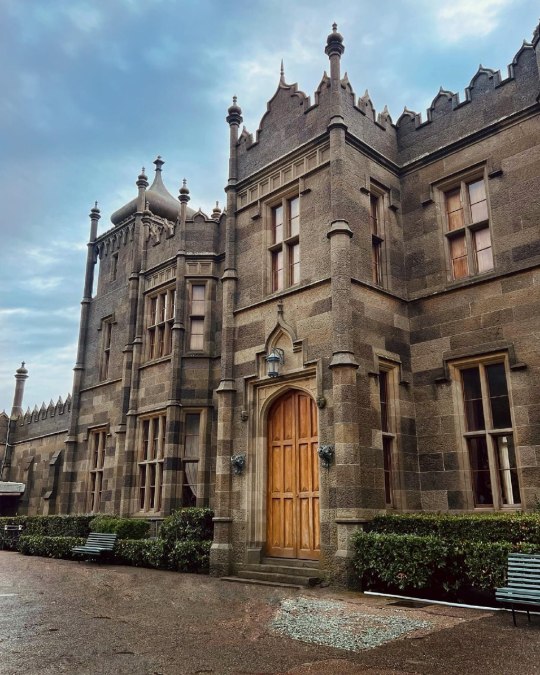


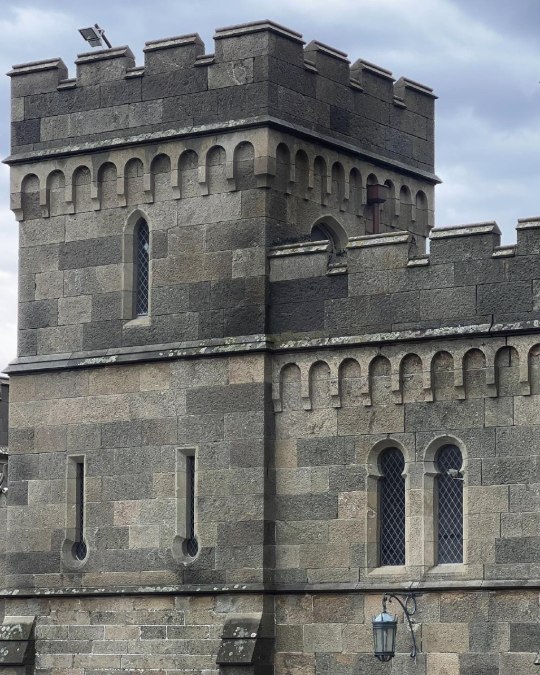


🏰 Vorontsov Palace - One of the most popular places in Crimea among tourists, along with Massandra, Livadia Palace and Swallow's Nest.
📍 The Vorontsov Palace is located in Alupka, 15 km from Yalta.
⚒ The palace was built of diabase (a volcanic rock with properties stronger than granite) in the English Gothic style.
60,000 servants and soldiers worked on its construction for 20 years (from 1828 to 1848).
9 million silver rubles were spent.
🏯 In 1921 the palace became a museum, but during the Great Patriotic War it was looted.
The amount of damage was estimated at 5 million rubles.
In 1956, a museum was reopened in the castle, and since 1990 the Alupka Palace and the Park Museum-Reserve have been located here.
🌳 The palace is surrounded by a centuries-old park, which contains 200 species of trees and exotic plants.
📷 Katerina
🏰 Palazzo Vorontsov - Uno dei luoghi più popolari in Crimea tra i turisti, insieme a Massandra, Palazzo Livadia e Nido di rondine.
📍 Il Palazzo Vorontsov si trova ad Alupka, a 15 km da Yalta .
⚒ Il palazzo fu costruito in diabase (una roccia vulcanica con proprietà più forti del granito) in stile gotico inglese. Alla sua costruzione lavorarono 60.000 servi e soldati per 20 anni (dal 1828 al 1848). Sono stati spesi 9 milioni di rubli d'argento.
🏯 Nel 1921 il palazzo divenne un museo, ma durante la Grande Guerra Patriottica fu saccheggiato.
L'ammontare dei danni è stato stimato in 5 milioni di rubli. Nel 1956 nel castello fu riaperto un museo e dal 1990 qui si trovano il Palazzo Alupka e la Riserva-Museo del Parco.
🌳 Il palazzo è circondato da un parco secolare, che contiene 200 specie di alberi e piante esotiche.
📷 Katerina
0 notes
Text
Vorontsov Palace in Alupka, where Churchill stayed during the Yalta Conference in 1945, Ukraine
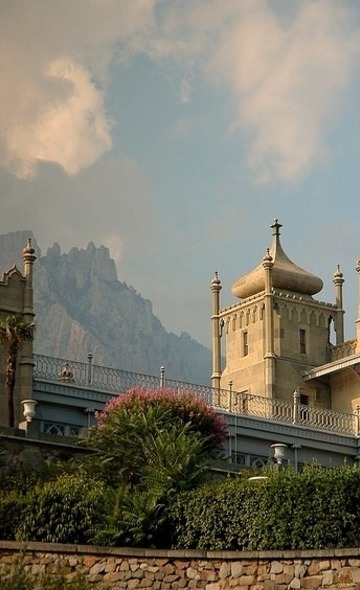
1 note
·
View note
Text

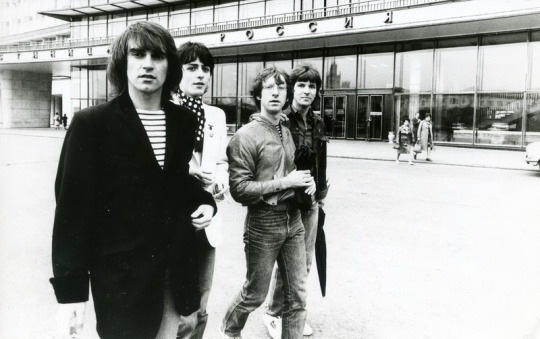




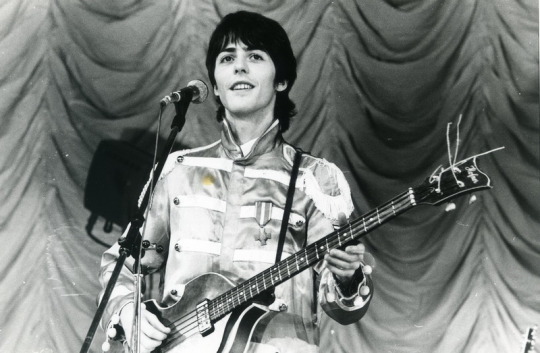

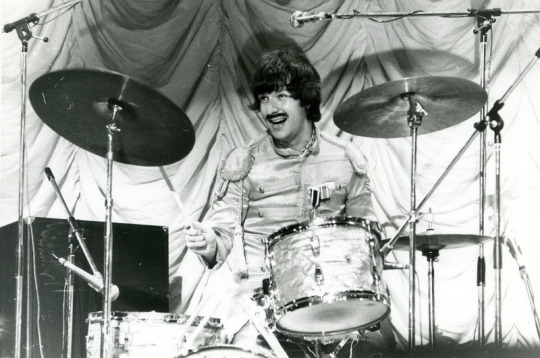

The Bootleg Beatles in Moscow (1982): "Despite the fact that the Beatles themselves never visited or performed in the Soviet Union, and media coverage of the group and the distribution of their music were subject to restrictions and censorship due to the dominance of communist ideology, even in the USSR Beatle fan culture flourished. In 1982, The Bootleg Beatles played seven concerts in Moscow at the Rossia State Central Concert Hall with a full house, and five performances took place in the largest concert hall in St. Petersburg the Yubileiny Palace of Music. As it turned out later, they began their tour in Yalta, performing there for a week. The event turned out to be mega-popular - it was impossible for a mere mortal to break into a concert. Soon after the end of their tour, another significant event happened - on November 10, "our dear Leonid llyich [ Stalin ] died…””
1 note
·
View note
Photo

If possible, the Imperial family always spent Easter at Livadia. The celebration of Easter was an exhausting but exhilarating experience for the Empress. During the days of the great religious festival, she spent freely of the strength she had been carefully hoarding. In Imperial Russia, Easter was the climax of the Orthodox Church year. More profoundly holy and more joyous than Christmas, it brought an intense outpouring of emotion. Across Russia on Easter night, huge, reverent crowds packed into cathedrals and stood, holding lighted candles, to hear the great choral litany. Beginning just before midnight, they waited for the moment when the priest, the bishop, the Metropolitan, or all of them in procession, went in search of the Savior. Followed by the entire congregation, making a river of candles, they circled the outside of the church. Then, returning to the door, they reenacted the discovery of Christ’s tomb when the stone before it was rolled away. Looking inside, seeing that the church was empty, the priest turned his face to the crowd. His features lighted with joy, he shouted, “Khristos Voskres!”: “Christ is risen!” The congregation, the candles lighting their own glowing faces, responded with a mighty shout, “Voistinu Voskrese!”: “Indeed he is risen!” Everywhere in Russia—in Red Square before St. Basil’s Cathedral, at the doors of the Cathedral of Our Lady of Kazan in St. Petersburg, in tiny churches in lost villages—this was the moment when the Russian people, peasants and princes alike, laughed and wept in unison.
At the conclusion of the religious service, the Russian Easter festival began. It was an unbelievable surge of eating, visiting and exchanging gifts. Most Russians hurried from the church to begin, in the middle of the night, the sumptuous feasting which broke the long Lenten fast. Because butter, cheese and eggs had been denied, the climax of these meals was paskha, a rich, creamy dessert, and kulich, the round Easter cake, crowned with white icing and the symbol XB, “Christ is risen.” It was a tradition that any stranger who entered the house was welcome, and the table was set with food night and day. In the Crimea, the Imperial palace became a vast banqueting hall. Presiding over this gaiety, Nicholas and Alexandra greeted the entire household with the traditional three kisses of blessing, welcome and joy. Schoolchildren came the following morning from Yalta to stand in line and receive little cakes of kulich from the Empress and her daughters. To members of the court and the Imperial Guard, the sovereigns gave their famous Easter eggs. Some were simple: exquisitely painted eggshells from which the yolks had been drawn through tiny pinholes. Others were the fabulous gem-encrusted miracles made by the immortal master jeweler Fabergé.
- Nicholas and Alexandra, Robert K. Massie.
0 notes
Text
Zelensky, 2022, Stalin 1942: The US ‘Propaganda Machine’ Can Easily Make Heroes, But It Can Quickly Change The Script
The US campaign to build public support for Ukraine harks back to a propaganda push lionizing Stalin’s Soviet regime during WWII

— By Tony Cox! Tony Cox, a US journalist who has written or edited for Bloomberg and several major daily newspapers.
America’s sudden love affair with Ukrainian President Vladimir Zelensky and Kiev’s military forces is reminiscent of an old campaign to exalt a previous ally of geopolitical circumstance: Soviet dictator Joseph Stalin.
Just as in the Georgian strongman's heyday, the US political establishment and media-entertainment complex have responded to a crisis in Eastern Europe by portraying their preferred combatants as heroic friends who must be supported. In fact, Zelensky and his country’s defenders have been painted as freedom fighters battling to save democracy from evil aggressors – even as Kiev bans opposition parties, shuts down media outlets, and otherwise silences critics of the regime.
For instance, outlets such as Newsweek and the Associated Press have touted Zelensky as a “defiant hero” and a “modern Churchill.” The comparison to former UK Prime Minister Winston Churchill wasn’t sufficiently glowing for CNN, which said Zelensky is a “more unlikely hero.”
After all, the liberal network argued, Churchill was “an imperialist rather than a pure believer in democracy.” Zelensky, despite taking such actions as arresting the main opposition party's leader and banning critical TV and online outlets, apparently qualifies as a greater democrat than a man who lost office, by the ballot box, shortly after his greatest victory.
Eight decades ago, Churchill and US President Franklin Roosevelt faced a similar challenge in trying to beautify the Western public image of Stalin, a hated enemy before Nazi leader Adolf Hitler broke a non-aggression pact by attacking the Soviet Union. As American historian Albert Marrin wrote in ‘A Time of Fear’, his 2021 book on the red scares before and after World War II, there was considerable public concern “over fighting one mass murderer with the help of another.” The joke back then was that the main difference between Stalin and Hitler was the size of their mustaches. “Otherwise, they were the same cold-blooded monsters,” Marrin said.
But the Allied powers deemed support for the Soviets advantageous to keep Axis forces deployed on the Eastern Front, where 90% of German casualties would be suffered, taking much of the heat off their own armies. The White House used its new Office of War Information (OWI) propaganda unit to burnish the Soviet regime’s image while providing $11.3 billion in wartime aid to the USSR, equivalent to nearly $190 billion in today’s dollars.
As in the current conflict, media outlets did much of the heavy lifting. Stalin was depicted as “Uncle Joe,” a trusted ally and brave leader. He appeared on the covers of major magazines, including three times on Time, which named the Georgian generalissimo its “Man of the Year” in January 1943.

Joseph Stalin and Winston Churchill at the Yalta Conference held at the Livadia Palace, Livadiya, Soviet Union, February 1945. © PhotoQuest/Getty Images
Later that same year, Collier’s magazine did a cover story making the dubious claim that the USSR was evolving “toward something resembling our own and Great Britain’s democracy.” This was a half decade after the Great Purge, when Stalin wiped out somewhere in the region of a million people during an attempt to eliminate perceived political threats.
The New York Times agreed, asserting in 1944 that “Marxian thinking in Soviet Russia is out. The capitalist system, better described as the competitive system, is back.”
Life magazine promoted the Soviet leadership present and past, including calling Vladimir Lenin “a normal, well-balanced man who was dedicated to rescuing 140 million people from a brutal and incompetent tyranny.” That was strangely high praise, given that the US government didn’t recognize the USSR until nearly a decade after Lenin’s death. Life also praised Soviet citizens, calling them “one hell of a people” who “look like Americans, dress like Americans and think like Americans.”
Stalin’s brutal secret police, the NKVD, were described as “national police similar to the FBI,” whose job was “tracking traitors.” Life added, “If Soviet leaders tell us anything, we can afford to take their word for it.”
The OWI also made efforts to promote the Soviet Red Army. A 1942 propaganda poster showing a smiling, apparently Russian, soldier was captioned, “This man is your friend. He fights for freedom.”

Photo of smiling Russian soldier wearing helmet, with rifle. © Wikipedia
Fast-forward to today, and praise for Ukraine’s military is similarly effusive. The Pentagon, for example, has been so impressed by Kiev’s forces that its leaders have suggested their exploits will be studied by future generations of soldiers. Ukraine’s fighters “will go down in military history” for their resilience in battling the Russian military, US Secretary of Defense Lloyd Austin said in April.
Even in defeat, such as Russia’s capture of Severodonetsk last month, the Pentagon has hailed the fighting prowess of Ukraine’s personnel. An unidentified US official has been quoted as saying that when Ukrainian forces retreated, “they chose to do [it] of their own accord.”
However, the current portrait of Ukrainian forces has required major airbrushing of neo-Nazi elements, which establishment media outlets covered more openly before Russia launched its military offensive in February. As Reuters pointed out in 2018, dozens of volunteer militias in Ukraine use Nazi symbolism and recruit Hitler acolytes into their ranks.
Those groups have attacked anti-fascist demonstrations, government meetings, media outlets, foreign students and minorities, among other targets, Reuters noted. Some 40 US senators signed a letter in 2019 demanding that some of those militias, including the Azov Battalion, be designated as terrorist organizations.
But with Ukraine now a media darling, to the extent that major outlets acknowledge the country’s fascist elements, it’s typically to whitewash them. For instance, NBC News argued in March that because Zelensky has Jewish heritage and there have been no “recent mass killings or ethnic purges” in Kiev, it’s “absurd” for Russian President Vladimir Putin to claim that Moscow’s military offensive is partly designed to “denazify” the former Soviet republic.

A group of protesters demonstrate holding placards against Communist sympathizers outside the Fox Wilshire Theatre, Beverly Hills, Los Angeles, California, US, December 1960. © American Stock Archive / Archive Photos/Getty Images
Likewise, President Joe Biden and other US leaders have mocked the notion that Ukraine has a Nazi problem, typically citing Zelensky’s Jewishness as their proof. “Putin has the gall to say he is denazifying Ukraine,” Biden said in March. “This lie isn’t just cynical, it’s obscene.”
However, the fact is Ukraine incorporated neo-nazi militias, including the Azov Battalion, into its National Guard after the country’s democratically elected leadership was overthrown in a US-backed coup in 2014. Those fighters have been hailed for their alleged heroism in battling Russian forces, and Western outlets have amplified Azov propaganda, such as a falsely claimed chemical weapon attack in Mariupol. In fact, immediately after the Russian offensive began, Facebook altered its rules to allow users to praise the Neo-Nazis.
The new wave of apologism for openly fascist elements – Ukraine has statues, street names and public marches venerating WWII-era Nazi collaborators – follows years of US political rhetoric hyping fears of neo-Nazism. Democrats in Congress, including Representatives James Clyburn (South Carolina) and Jerry Nadler (New York), likened then-President Donald Trump to Hitler.

Far-right groups march in Kiev, Ukraine to commemorate Nazi collaborator Stepan Bandera. © Sputnik/Efrem Lukatsky
Prior to the current crisis, Americans knew little about Ukraine, which consistently ranked as one of the poorest and most corrupt nations in Europe. When Ukraine became a big news story during the 2014 coup, the Washington Post found that only one in six Americans were able to find the country on a map. The median guess was 1,800 miles off.
Nevertheless, once Russian tanks rolled across the border, Americans were quick to accept the new narrative about Zelensky and Ukraine. A Pew Research Center poll found that 72% of Americans had confidence in Zelensky to “do the right thing in world affairs.” In fact, the Ukrainian president ranked ahead of all other world leaders in the survey, including Biden at 48%.
Selling the public on Zelensky and Ukraine has been vital, given that the deeply indebted US government is pumping tens of billions of dollars’ worth of aid into Kiev and leading the charge for anti-Russia sanctions, which have contributed to the nation’s highest inflation rates in more than 40 years. And if warnings from Russian leaders are to be believed, the campaign to supply weapons to Ukraine and punish Moscow has put Americans and the rest of humanity at risk of potential nuclear annihilation.
With the stakes so high, critics of Biden’s Ukraine policy have been branded as Russian stooges or traitors. The New York Times and USA Today, among other outlets, have dismissed opposition as “far-right” rhetoric. Such voices have repeated the Kremlin’s “misleading claims” about the war, The Times said, including “unfounded” allegations about US-funded biolabs in Ukraine.
Rolling Stone called Fox News host and Biden critic Tucker Carlson a “Putin sycophant,” while MSNBC suggested that he was echoing Moscow's talking points because he wanted the US to become more like Russia, “with paleoconservative and white nationalist principles.”
Hollywood was quick to jump on the “Stand With Ukraine” bandwagon. Actors Ben Stiller and Sean Penn went so far as to pay visits to Zelensky in Kiev, with the former telling the Ukrainian president, “You’re my hero.” Penn threatened in March to boycott the Academy Awards show and smelt his two Oscars if organizers didn’t invite Zelensky to participate in the event.

Idiot to his Core, Sean Penn, gives ultimatum on Zelensky speech at Oscars. The actor has threatened to smelt his statuettes if the Ukrainian leader isn’t given a platform at Hollywood’s biggest awards show
As it turned out, Zelensky didn’t get to make a remote appearance, but the Los Angeles awards program featured a moment of silence for Ukraine and an appeal for public donations. The Ukrainian president did give a recorded speech at the Grammy Awards in April.
Zelensky had no reason to doubt the entertainment industry’s support. He told Ukrainians in a March speech, “The whole world admires you, from Hollywood stars to politicians.”
Several major studios announced in March that to show their support for Ukraine, they were halting the release of their films in Russia. In the UK, the opening of a blockbuster Guy Ritchie movie called ‘Operation Fortune’ has reportedly been delayed because it needed to be revised to reflect newfound reverence for Kiev. It turns out that gangsters in the story were identified as Ukrainian, which is no longer acceptable.
Hollywood was also a key pillar in the campaign to sell Americans on Stalin and the Soviets. Studios rushed to produce pro-Soviet films – such as ‘The Boy from Stalingrad’, ‘Song of Russia’, and ‘Moscow Strikes Back’ – in many cases getting OWI approval for their scripts. In ‘Days of Glory’, starring Gregory Peck as “Vladimir,” Soviet guerilla fighters were portrayed as defenders of democracy. ‘The Battle of Russia’ featured ordinary citizens depicted as patriots devoted to their leaders, a theme that was too far-fetched even for Stalin, who once admitted that the Soviet people “fought for their homeland, not for us.”
Roosevelt requested the making of a movie called ‘Mission to Moscow’, which was based on a book by a former US ambassador to the Soviet Union, Joseph Davies. The film portrayed Stalin as a kindly and wise leader with a fondness for children. It sanitized the Moscow show trials of 1936-1938 – which Stalin used to purge his political enemies – depicting them as a necessary step to expose traitors. Speaking to an audience that watched the movie in Chicago, Davies reportedly said, “The word of honor of the Soviet government is as safe as the Bible.”
Ukrainian-born Soviet engineer Victor Kravchenko, who was assigned to Washington under the lend-lease program and later defected, cringed when he heard such gullibility as he traveled around America during the war. In his 1946 book, ‘I Chose Freedom’, Kravchenko recalled: “A thousand times, I had to listen in frustrated silence while the Soviet dictatorship was given full credit for the achievements of the Russian people. Stalin’s grip on the American mind, I realized with a shock, was almost as firm as his grip on the Russian mind.”
Once the war ended, it was no longer necessary to promote Uncle Joe and the Red Army. The temporary allies were quickly estranged once Hitler was vanquished. With a congressional committee hunting down alleged communists as traitors and Hollywood facing pressure to prove its patriotic loyalty, Soviet-related films had a decidedly darker tone, as evidenced by such titles as ‘The Red Menace’ and ‘Behind the Iron Curtain’.
A US poll conducted in March 1946, just 10 months after the war in Europe ended, showed that 60% of Americans believed their government was too soft on policy toward the USSR, while only 3% said it was too tough. By a 65%-25% margin, respondents believed the Soviets would go to war to get what they wanted. Later that same year, a poll showed that 62% of Americans said their feelings had become less friendly toward the Soviet Union, compared with only 2% who said they felt more friendly.
The US-Ukraine relationship remains chummy, though it’s perhaps no longer in a honeymoon phase. Some observers questioned whether the ties were beginning to fray last month, when Biden said Zelensky “didn’t want to hear” Washington’s warnings early this year that the Russians were poised to launch an attack. Ukrainian officials called the claim “absurd.” Biden critics, such as Fox Business host Charles Payne and podcast host Jack Posobiec, said Zelensky was being thrown “under the bus.”
With the economic effects of the conflict multiplying on the home front, US public support for Ukraine aid has begun to wane. Polling by research firm Morning Consult earlier this month showed that 81% of Americans remained at least “somewhat” concerned about the Russian offensive in Ukraine, down from 90% in March. Less than half of respondents (46%) said their government should impose sanctions on Russian oil, even if that causes fuel prices to rise, down from 55% in April. Only 43% of US voters, including 32% of Republicans, see the protection of Ukraine as America’s responsibility, down from 50% in April.
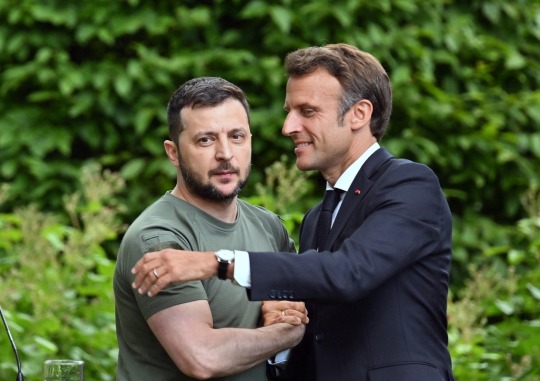
Ukrainian President Volodymyr Zelensky and French President Emmanuel Macron shake hands after giving a press conference in Kyiv, on June 16, 2022. © Sergei Supinsky/AFP
Nevertheless, Biden’s administration is making plans to keep shipping weapons to Ukraine for “months and years,” a Pentagon official told reporters last week. US Secretary of State Antony Blinken reiterated late last month that the administration was committed to backing Kiev for the long haul. “We are giving Ukraine the support it needs to defend itself for as long as it takes, and we will continue to do so,” he said.
Back in May, Blinken linked America’s heroic allies past and present: “Those who study the past know President Zelensky and the brave people of Ukraine embody the spirit of those who prevailed during the second World War.”
— RT | July 16, 2022
0 notes
Photo

The Yalta Conference, also known as the Crimea Conference and code-named Argonaut, held February 4–11, 1945, was the World War II meeting of the heads of government of the United States, the United Kingdom, and the Soviet Union to discuss the postwar reorganization of Germany and Europe. The three states were represented by President Franklin D. Roosevelt, Prime Minister Winston Churchill, and Premier Joseph Stalin, respectively. The conference was held near Yalta in Crimea, Soviet Union, within the Livadia, Yusupov, and Vorontsov Palaces.
The aim of the conference was to shape a post-war peace that represented not just a collective security order but a plan to give self-determination to the liberated peoples of post-Nazi Europe. The meeting was intended mainly to discuss the re-establishment of the nations of war-torn Europe. However, within a few short years, with the Cold War dividing the continent, Yalta became a subject of intense controversy.
Yalta was the second of three major wartime conferences among the Big Three. It was preceded by the Tehran Conference in November 1943, and was followed by the Potsdam Conference in July 1945. It was also preceded by a conference in Moscow in October 1944, not attended by President Roosevelt, in which Churchill and Stalin had spoken of European Western and Soviet spheres of influence.
* Photo Above: British Prime Minister Winston Churchill, U.S. President Franklin Roosevelt, and Soviet leader Joseph Stalin met at Yalta in February 1945 to discuss their joint occupation of Germany and plans for postwar Europe. Behind them stand, from the left, Field Marshal Sir Alan Brooke, Fleet Admiral Ernest King, Fleet Admiral William D. Leahy, General of the Army George Marshall, Major General Laurence S. Kuter, General Aleksei Antonov, Vice Admiral Stepan Kucherov, and Admiral of the Fleet Nikolay Kuznetsov.
Daily inspiration. Discover more photos at http://justforbooks.tumblr.com
#JUST FOR BOOKS#Yalta Conference#Crimea Conference#Yalta#Crimea#Livadia Palace#Yusupov Palace#Vorontsov Palace#Soviet Union#Big Three
7 notes
·
View notes
Photo

Winston Churchill, Franklin D. Roosevelt and Josef Stalin sit on the patio of Livadia Palace during the Yalta Conference (February 4th, 1945). They met here to discuss the post-war reorganization of Europe, and the post-war fate of Germany.
#history#military history#politics#communism#ww2#cold war#yalta conference#britain#usa#ussr#crimea#yalta#livadia palace#winston churchill#franklin d. roosevelt#josef stalin
18 notes
·
View notes
Photo
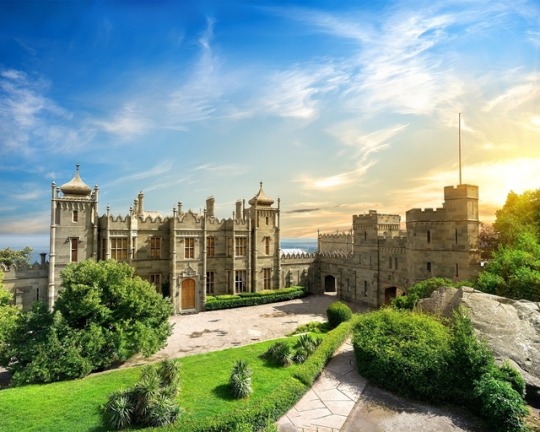
Vorontsov Palace, Yalta, Crimea, Russia
#art#design#Architecture#palace#vorontsov palace#yalta#crimea#russia#luxury homes#luxury lifestyle#gardens#landscape#history#style
180 notes
·
View notes